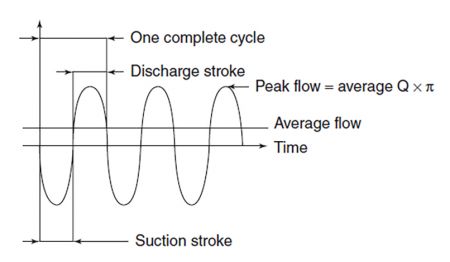
What is acceleration head and how can it be calculated?
Acceleration head is a primary concern in reciprocating pump systems, due to the acceleration and deceleration of the liquid in the suction piping of these types of pumps. An example of the pulsating from a reciprocating pump is shown in Image 1. This shows how the flow starts and stops with every cycle, which requires accelerating the liquid and causes the repetitive acceleration head.

The pressure drop caused by the acceleration is offset by the increase in pressure when the liquid decelerates. Therefore, the average pressure in the suction line is calculated without consideration of acceleration head. However, acceleration head is a loss when calculating net positive suction head available (NPSHa), and to ensure a reciprocating pump will fill properly, the acceleration head must be considered. This is particularly important with higher speed, relatively long suction lines or suction lines that have high velocity.
Where:
Hacc = acceleration head in meters or feet
L = actual length of suction line in meters or feet
V = average liquid velocity in m/s or ft/s
N = speed of pump crankshaft in rpm
C = pump type constant
= 0.400 for single-acting simplex
= 0.200 for single-acting duplex
= 0.115 for double-acting duplex
= 0.066 for triplex
= 0.040 for quintuplex
= 0.028 for septuplex
g = acceleration due to gravity = 9.81 m/s2 (32.2 ft/s2)
k = constant depending on fluid compressibility
= 1.4 for noncompressible liquids such as deaerated water
= 1.5 for most liquids
= 2.5 for compressible liquids (such as ethane)
Equation 1
The head required to accelerate the liquid column is a function of the length of the suction line, the average velocity in this line, the pump speed, pump type and the relative elasticity of the liquid and pipe. See Equation 1 for the calculation.

